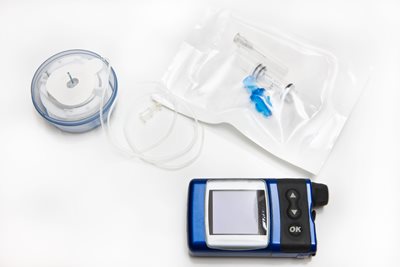
Skin Reactions Common at Insulin Pump Infusion Sites
Skin reactions at insulin pump infusion sites are common among people with type 1 diabetes who use the devices and can lead to delivery failure, new research suggests.
Insulin pump use is increasingly common, but many patients experience infusion site failure that in some cases leads to discontinuation. In a novel investigation, researchers at the University of Washington, in Seattle, used biopsies and noninvasive imaging to compare insulin pump sites with control sites in 30 patients. Several differences were found at pump sites in comparison with control sites, including fibrosis, inflammation, eosinophils, and increased vessel density.
"These findings support allergic sensitization as a potentially common reaction at [insulin pump] sites. The leading candidates causing this include insulin preservatives, plastic materials, and adhesive glue used in device manufacturing," write Andrea Kalus, of the university's dermatology division, and colleagues. The findings were published recently in Diabetes Care.
The inflammatory response, they say, "may result in tissue changes responsible for the infusion site failures seen frequently in clinical practice."
Such infusion site problems represent an "Achilles heel" of these otherwise highly beneficial devices, lead author Irl Hirsch, professor of medicine in the Division of Metabolism, Endocrinology, and Nutrition, said in a statement. "It doesn't really matter how good the technology is. We still don't understand what is happening with the infusion sites, much less to [be able to] fix it."
Significant Differences Between Pump and Non-Pump Sites
In the cross-sectional study, Kalus and colleagues used noninvasive optical coherence tomography (OCT) immediately prior to performing punch biopsies at three sites: the site currently in active use, the "recovery site" used 3–5 days prior to the procedures, and control sites never used for pump infusion. Punch biopsies were also performed at those sites.
The mean age of the patients was 48.3 years, the mean diabetes duration was 30.4 years, and the mean duration of pump use was 15.8 years. Nearly all patients (93.3%) reported itchiness at the site, and 76.7% reported skin redness.
Of the 25 patients for whom OCT imaging was successful, statistical analysis showed significant differences in vascular area density and the optical attenuation coefficient, a surrogate for skin inflammation, between the pump and control sites and between recovery sites and current pump sites. The greater vessel density is likely a result of injury and repair related to catheter insertion, the authors say.
In the biopsy samples, both current and recovery sites showed increased fibrosis, fibrin, inflammation, fat necrosis, vascularity, and eosinophils compared to the control sies, but no significant differences were found between current and recovery sites.
Eosinophils: "The Most Surprising Histologic Finding"
Eosinophils were found in 73% of skin biopsy specimens from current sites and in 75% of specimens from recovery sites, compared to none from the control sites (for both, P < .01). In all study participants, eosinophils were found in at least one current and/or recovery infusion site deep in the dermis near the interface with fat. The number of eosinophils ranged from zero to 31 per high-power field, with a median of 4.
The number of eosinophils didn't vary by type of insulin or brand of pump, but higher counts were seen in those who had used pumps for less than 10 years compared to more than 20 years (P = .02).
The prevalence and degree of eosinophils were "the most surprising histologic finding," the authors say. They note that "eosinophils are not typically present as a component of resident inflammatory cells in the skin."
While eosinophils may be present in normal wound healing, "the absolute number and density of eosinophil in these samples support a delayed-type hypersensitivity response, which is typically observed between 2 and 7 days after exposure to an allergen.... Eosinophils are often correlated with symptoms of itchiness and likely explain the high percentage of participants who reported itchiness in this study," Kalus and colleagues write.
Correlation Found Between Inflammation and Glycemic Control
All participants used the Dexcom G6 continuous glucose monitor as part of their usual care. Inflammation scores were positively correlated with insulin dose (P = .009) and were negatively correlated with time in range (P = .01).
No other OCT or biopsy findings differed by duration of pump use, previous use of animal insulin, or type of insulin.
The reason for these findings is unclear, Hirsch said. "How much was the catheter or the insulin causing the irritation around the sites? How much was it from the preservatives, or is this because of the insulin pump itself? All these questions need to be answered in future studies.... The real goal of all of this is to minimize skin damage and improve the experience for our patients."
The study was funded by the Leona M. and Harry B. Helmsley Charitable Trust. Hirsch reports grants and contracts from Insulet, Medtronic, and Dexcom, Inc, outside the submitted work; consulting fees from Abbott Diabetes Care, Lifescan, and Hagar outside the submitted work; and
honoraria for lectures, presentations, participation on speaker's bureaus, manuscript writing, or educational events as section editor for UpToDate outside the submitted work. Kalus has no disclosures.
Diabetes Care. Published online July 14, 2023. Abstract
Miriam E. Tucker is a freelance journalist based in the Washington DC area. She is a regular contributor to Medscape, with other work appearing in the Washington Post, NPR's Shots blog, and Diabetes Forecast magazine. She is on Twitter @MiriamETucker.
Article from medscape.com.
------------------------------------------------------------------------------------------------
Expand your knowledge on the topic of diabetes with our expansive list of diabetes-related continuing education courses:
- Diabetes: An Introduction
- Diabetes Medications
- Diabetes Medications: Part 2
- Diabetes: Metabolic Syndrome and Prediabetes
- Diabetes Overview: Type 1, Type 2, and Gestational Diabetes
- Diabetes Related Conditions and Complications
- Diabetes Management and Insulin Pumps
- Diabetes Management and Insulin Pumps for School Nurses
Pedagogy's courses are available for purchase by the individual or facility. For individuals, register with us to create your username and password, click on the course title of interest and then click the Purchase button. For a complete listing of all our online continuing education courses, including the largest selection of infusion continuing education courses offered online, click here!
For organizations that would like to purchase education for their entire staff, email sales@pedagogyeducation.com and let us know the course(s) of interest and how many staff members you need to provide education for, and we will be happy to send you a price quote.

